Our next destination was Kaikoura, but we had to return to Picton first to pick up Chris’s glasses. It was only a brief detour off route and we were soon heading down the east coast. The nearer we got to Kaikoura, the more roadworks we came across, work still being done as a result of the 2018 earthquake. There were numerous traffic control points where we could watch the seals on the beach as we waited. Those that controlled the “Stop/Go” signs were a cheery bunch and made sure that they waved a “Thank you” to every vehicle. It cheered us to see people happy in their work, however tedious it was, and we never failed to wave back at them.
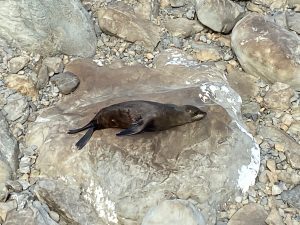 At one point the new road construction had included a lay-by where there was a large seal colony. Just how many seals there were was not apparent at first; dark grey or black seals lounging on dark grey or black volcanic rocks, meant you had to allow your eyes to adjust. Then we saw the extent of the colony, too many to count.
At one point the new road construction had included a lay-by where there was a large seal colony. Just how many seals there were was not apparent at first; dark grey or black seals lounging on dark grey or black volcanic rocks, meant you had to allow your eyes to adjust. Then we saw the extent of the colony, too many to count.
 Our AirBnB property in Kaikoura was described as ‘The Cottage with Sea Views’. It wasn’t in the heart of Kaikoura but high up on the hill towards Point Kean. As we entered the house, I was greeted with a stunning view out to sea beyond the sliding patio doors. I was so enamoured by the view that I, forgetting the glass door, walked straight into it with a thump. Outside was a deck looking down the hill to Kaikoura, the waterfront and the glistening sea stretching to the horizon and beyond. What a view to enjoy, and what a shame we were only staying here for one night.
Our AirBnB property in Kaikoura was described as ‘The Cottage with Sea Views’. It wasn’t in the heart of Kaikoura but high up on the hill towards Point Kean. As we entered the house, I was greeted with a stunning view out to sea beyond the sliding patio doors. I was so enamoured by the view that I, forgetting the glass door, walked straight into it with a thump. Outside was a deck looking down the hill to Kaikoura, the waterfront and the glistening sea stretching to the horizon and beyond. What a view to enjoy, and what a shame we were only staying here for one night.
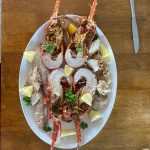 With such a view, we decided to eat in, and as Kaikoura is the crayfish capital of the world. John and I went in search of crayfish from a small shop on the outskirts of town, appropriately called Cods & Crayfish. There we bought some fresh, prepared crayfish and fillets of blue cod from an amiable chap who clearly knew his way around a rugby pitch. Conversation told us that he had played hooker all of his playing career, which he had managed to survive without injury.
With such a view, we decided to eat in, and as Kaikoura is the crayfish capital of the world. John and I went in search of crayfish from a small shop on the outskirts of town, appropriately called Cods & Crayfish. There we bought some fresh, prepared crayfish and fillets of blue cod from an amiable chap who clearly knew his way around a rugby pitch. Conversation told us that he had played hooker all of his playing career, which he had managed to survive without injury.
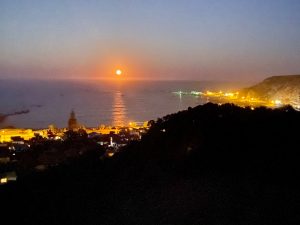 The seafood, beautifully prepared back at the house was superb. As we ate day turned into night and the moon rose out of the sea casting a warm orange glow over the water. What a tranquil place to be on such an evening. But the house was more than the view; it felt like a home, and one that was well loved.
The seafood, beautifully prepared back at the house was superb. As we ate day turned into night and the moon rose out of the sea casting a warm orange glow over the water. What a tranquil place to be on such an evening. But the house was more than the view; it felt like a home, and one that was well loved.
We were due at the Whale Watch Centre quite early as we were due out on the 8.00am sailing. Having gone through the briefing, we boarded the bus to take us round to the quay on the other side of Point Kean.
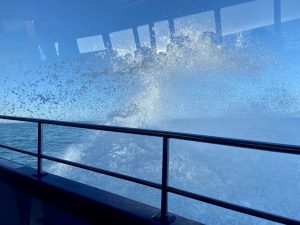 We had been warned that there was a reasonable swell off-shore. Angela was losing her appetite for the trip, despite taking precautions against sea sickness in advance. As we emerged from the protection of the quay, we soon realised that we were in for a bit of a bumpy ride. As we powered out to sea we scythed our way through most of the waves but had to adjust our speed whenever we approached a bigger one, that would slap noisily into the twin hulls of the catamaran. We hadn’t gone very far when we were joined by a pod of Dusky dolphins riding the bow wave and leaping clear of the water. They moved so fast that they were impossible to photograph, appearing and disappearing in a flash of glimmering, grey skin.
We had been warned that there was a reasonable swell off-shore. Angela was losing her appetite for the trip, despite taking precautions against sea sickness in advance. As we emerged from the protection of the quay, we soon realised that we were in for a bit of a bumpy ride. As we powered out to sea we scythed our way through most of the waves but had to adjust our speed whenever we approached a bigger one, that would slap noisily into the twin hulls of the catamaran. We hadn’t gone very far when we were joined by a pod of Dusky dolphins riding the bow wave and leaping clear of the water. They moved so fast that they were impossible to photograph, appearing and disappearing in a flash of glimmering, grey skin.
The dramatic distraction of leaping dolphins failed to stave off Angela’s nausea as she wished she hadn’t eaten any breakfast.
We were looking for Sperm Whales, which live in the waters off Kaikoura all year round because of the rich pickings there. We had seen bright red plankton and krill on the surface, something I had never seen before, but they are a sign of the richness of the seas here. Sperm whales do not eat plankton but they do eat other marine creatures that congregate to feed on them, squid amongst them.
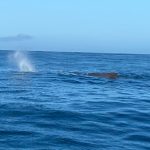
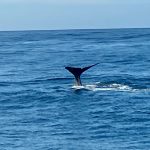 The whale will spend about forty five minutes several hundred metres below the surface, feeding. When they need to take in air, they come to the surface to take thirty or forty breaths before diving again. The give away sign we were looking for was the spout of water on an exhale. Having spotted one we sped to where the whale was on the surface. There isn’t a huge amount to see, just a sliver of its back and dorsal fin, with the occasional spout. Our expert guide on board is able to read the signs and warn us that the whale is about to dive. It takes a deep breath and begins to arch its back. As it dives the tail gradually arcs above the surface, revealing its majestic flukes, before disappearing for another forty five minutes or so.
The whale will spend about forty five minutes several hundred metres below the surface, feeding. When they need to take in air, they come to the surface to take thirty or forty breaths before diving again. The give away sign we were looking for was the spout of water on an exhale. Having spotted one we sped to where the whale was on the surface. There isn’t a huge amount to see, just a sliver of its back and dorsal fin, with the occasional spout. Our expert guide on board is able to read the signs and warn us that the whale is about to dive. It takes a deep breath and begins to arch its back. As it dives the tail gradually arcs above the surface, revealing its majestic flukes, before disappearing for another forty five minutes or so.
We were fortunate enough to see a further two whales before it was time to head back. Angela had seen the whales between bouts of sickness. As we returned we were confined to the cabin. I sat with Angela on one side of me and a German woman vomiting on the other. Throughout my career I had always said, “I don’t do vomit!” I certainly got the short straw.
It is a fabulous experience watching these majestic creatures of the deep, as well as the Dusky dolphins and the Albatross swooping over the surface.

